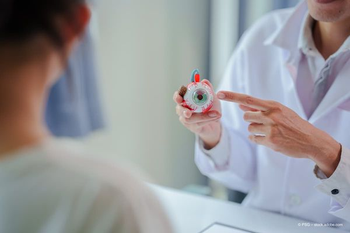
WIO 2024: An educator's perspective on shattering glass ceilings in ophthalmology
Fasika Woreta, MD, spoke about shattering glass ceilings in ophthalmology, highlighting the importance of diversity, mentorship, and empowering women in leadership roles within the field during her WIO Honorary Lecture and Award.
Fasika Woreta, MD, sat down with our editorial team to talk about her Women in Ophthalmology (WIO) Honorary Lecture and Award, "Shattering Glass Ceilings in Ophthalmology: An Educator's Perspective."
Woreta is the Eugene de Juan, MD, Professor of Ophthalmic Education at Wilmer Eye Institute’s Baltimore and Columbia locations. She currently serves as the director of the Eye Trauma Center and the director of the Ophthalmology Residency Program at the Wilmer Eye Institute in Baltimore, Maryland.
Here are some of the highlights of Woreta’s discussion with Group Editorial Director Sheryl Stevenson.
Video Transcript:
Editor's note: The below transcript has been lightly edited for clarity.
Sheryl Stevenson: We are here today with Dr. Fasika Woreta, who will be attending this year's Women in Ophthalmology (WIO) Summer Symposium this weekend in Carlsbad, California. I know you're also presenting the WIO Honorary Lecture, so congratulations to you. Would love to learn a little bit more about your talk. What can you tell us?
Fasika Woreta, MD: Thank you, Sheryl. I'm really honored to be giving the Honorary Lecture about shattering glass ceilings in ophthalmology, and I'm doing it from a perspective of a residency program director. So first of all, I'm really proud of Dr. Christina Weng, who is the current WIO president. So she was actually a year behind me in residency at Wilmer [Eye Institute], so to see her as professor at Baylor [College of Medicine] and president of WIO is just amazing, so speaking of shattering glass ceilings.
WIO has meant so much to me as an organization. All the leadership: it's just a terrific group of women who really bring each other up. So I will be talking about the current state of diversity in ophthalmology. This is sort of like preaching to the choir, to this group. And I think the group, Women in Ophthalmology, symbolizes what we need to do in terms of increasing diversity and shattering glass ceilings in terms of supporting each other. At this meeting, you can see it gives a forum for women to give presentations. They have a program for medical students, which has been hosted by Dr. Roni Levin and others. And so I'll be talking about some of these pathway programs within Women in Ophthalmology. So it's mentorship, opportunities for networking, giving speaking opportunities. Their award session is amazing to recognize contributions of mentorship, research, and education of its members.
So I'll be talking about how we have now around 43% of women are in academia, in terms of when we look at the makeup and when we look at the medical student body, it's 55% so there is a disconnect between the diversity we see [in] the medical student body versus in women entering ophthalmology, as well as specifically in academia. And as we know, when you go up the ranks of leadership, we see a substantial decline in terms of the amount of women full professors. So that drops significantly from the 40% and then the chairs. So 20% of the chairs now are currently women, so it's definitely a lot better, but still a lot more to go in terms of that. So I'll be talking about barriers, which a lot of us are familiar with in terms of biases, harassments experienced in terms of lack of finding supportive mentorship, sort of institutional, structural inequities like lack of term limits that make it hard to advance. And so I'll be talking about that.
I really want to focus on solutions to reduce and continue to help shatter glass ceilings in ophthalmology, such as, again, a lot of the work Women in Ophthalmology is doing. There's a group at AUPO [that] Dr. Misha Syed and Dr. Rukhsana Mirza started called Women Professors of Ophthalmology. And so I feel, you know, the message is really for those in the audience, and there'll be a lot of trainees in terms of the necessary need for women in academia. Because in academia, we're sort of the gatekeepers of who enters the field. And the trainees need to see us in positions of leadership. Many chairs have women chairs like Dr. Kathryn Colby, Dr. Terri Young, Dr. Joan Miller, they've been an example for us in terms of and helped women greatly in terms of professional advancement and sponsorship. So that in the nutshell is of what I'll be talking about.
Stevenson: What might be a key takeaway that you would really hope audience members take away from your lecture?
Woreta: I hope the many trainees in the audience hear what a great path it is for women in academia, and I hope many of them do join and become med student educators, residency program directors, chairs. And for those not in academia, you can see great examples of leaders in the private-practice setting in terms of industry or in the organizations like Women in Ophthalmology. And so there's a role for all of us to play, no matter what career setting we're in, in terms of promoting other women and helping the field advance. And then hopefully, in another 10 years, we'll see the number go from 20% women chairs to closer to what we're seeing in terms of women now being more common than men in US medical schools.
Stevenson: As an educator, what strategies have you found to be most effective in empowering the next generation of ophthalmologists to really strive for leadership roles in the field?
Woreta: I think specifically in academia, it can be daunting, and again, for women facing additional challenges. But I think the strategies are first and foremost, which we'll all say is, is mentorship. So you know, many of us are in our positions today because of mentors, and it does certainly help to have female mentors as well. I feel if we don't see examples of females at our institutions, then you're not going to attract the best and brightest. So I would say mentorship, sponsorship. So the ability to be given opportunities to advance is something that women are good at giving other women I feel so they'll intentionally give opportunities. And you have to think about it, and again, be intentional about that. And so I think first and foremost is mentorship and sponsorship.
And then also, again, programming is intentional programming, such as Women Professors of Ophthalmology, Women in Ophthalmology. We were looking at other groups like Women in Surgery, Women in ENT, but I do think that Women in Ophthalmology is the strongest example of a women in surgery group in terms of how fast the organization has grown and what the annual meeting has become as well as all the activities that go on all year.
Stevenson: Anything else to add that we haven't touched upon?
Woreta: I'm taking my family along. Women in Ophthalmology also kind of represents...They have special programming for kids, and they're really family friendly, so I think it really sort of embodies what meetings should be like. And I think the American Academy of Ophthalmology is going to have childcare this year. II think welcoming families is also an important part and providing flexibility.
So actually, we saw for the board examination for the number of women board examiners went up once we had flexibility in terms of virtual opportunities to examine. So now the board exams are all virtual as well as flexibility in terms of the number of days that you need to be an examiner. So it used to have to be, I think, 3 days in a row in person, but now it's virtual and you can choose 2 days for 8 hours, for example, so you can see that allowed for flexibility. And then when we saw the number of women examiners jump significantly with the advent to virtual so I think thinking about how to make things flexible, incorporate families, I think can help relieve sort of burnout and a lot of the barriers that women in our field face.
Newsletter
Keep your retina practice on the forefront—subscribe for expert analysis and emerging trends in retinal disease management.








































